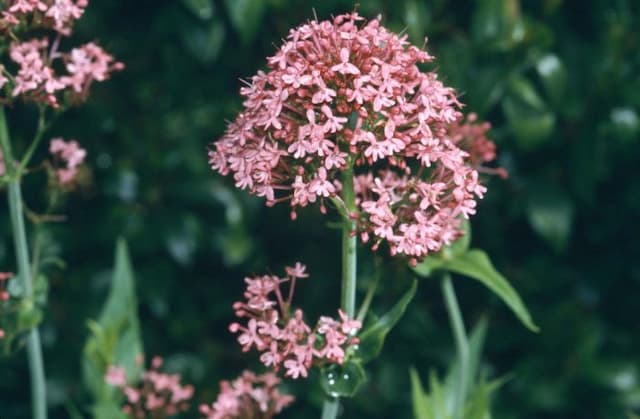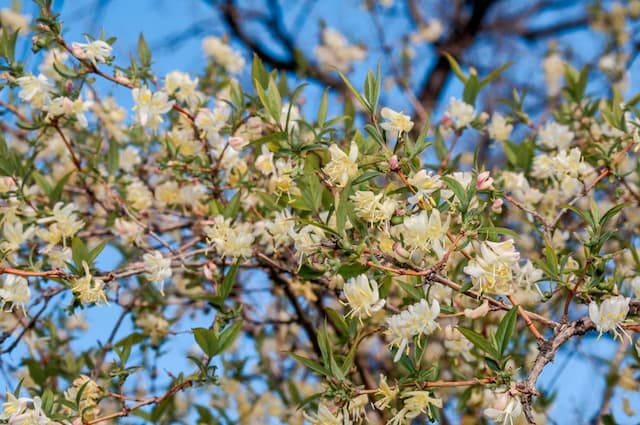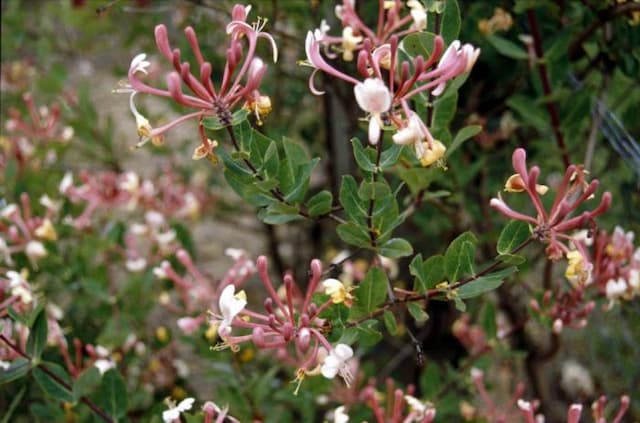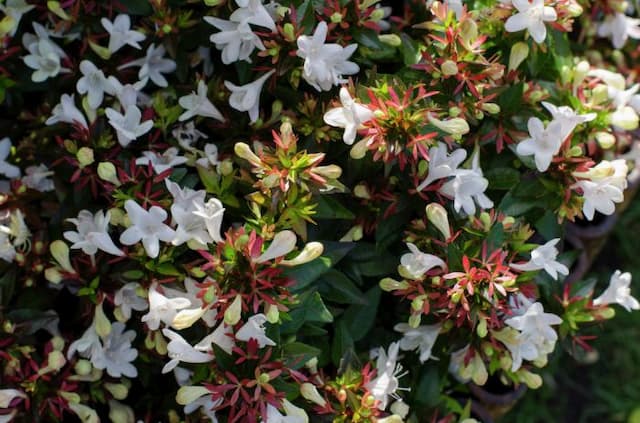Glossy Abelia Abelia × grandiflora Magic Daydream = 'Opstal103'

ABOUT
Abelia × grandiflora Magic Daydream, commonly referred to as simply Abelia, is an ornamental shrub with a visually captivating appearance. It boasts a semi-evergreen nature, meaning that it retains some of its leaves throughout the year, depending on the climate. The foliage of this Abelia is a standout feature, with leaves that display a blend of soft green, yellow, and creamy white tones, creating a variegated effect that adds a splash of light to any garden space. Throughout the blooming season, the Abelia Magic Daydream produces an abundance of flowers that are a delight for both the eyes and the local pollinators. The flowers are small, trumpet-shaped, and tend to cluster together, providing the appearance of bouquets dotted across the shrub. They exude a subtle, sweet fragrance that further enhances their allure, making them irresistible to bees and butterflies. The blossoms are mainly white, sometimes exhibiting a hint of pale pink, particularly at the base or edges of the petals, adding a delicate flush of color to the overall display. The plant has a bushy growth habit, creating a full and lush appearance with its branches generously clothed in the variegated leaves and floral clusters. The stems gracefully arch, adding a sense of movement and softness to the plant’s structure. With seasonal changes, the foliage may take on a slight color shift, often getting a pinkish undertone that complements the cooler weather and provides interest throughout the year. Overall, the Abelia Magic Daydream offers a multi-sensory experience through its vibrant and varied foliage, charming flowers, and inviting fragrance. Its well-rounded visual appeal makes it a favored choice for gardeners looking to add a touch of magic to their landscapes.
About this plant
 Names
NamesFamily
Caprifoliaceae
Synonyms
Magic Daydream Abelia, Dwarf Glossy Abelia
Common names
Abelia × grandiflora Magic Daydream = 'Opstal103'.
 Toxicity
ToxicityTo humans
Abelia is not typically known to be toxic to humans. There are no significant symptoms associated with poisoning from abelias as they are generally considered non-toxic. Therefore, ingesting parts of this plant is not expected to have serious consequences for human health.
To pets
Abelia is not typically known to be toxic to pets either. Similar to humans, it does not have a known history of causing significant symptoms or poisoning in animals, which suggests that ingestion of this plant by pets is unlikely to lead to serious health issues.
 Characteristics
CharacteristicsLife cycle
Perennials
Foliage type
Semi-deciduous
Color of leaves
Green
Flower color
White
Height
2-3 feet (0.6-0.9 meters)
Spread
3-4 feet (0.9-1.2 meters)
Plant type
Shrub
Hardiness zones
6
Native area
China
Benefits
 General Benefits
General Benefits- Attracts Pollinators: This plant attracts bees, butterflies, and other pollinators, which is beneficial for the garden ecosystem and promotes biodiversity.
- Low Maintenance: Requires minimal care once established, making it an ideal choice for gardeners of all skill levels.
- Drought Tolerant: Once established, it can withstand periods of low water availability, reducing the need for frequent irrigation.
- Year-Round Interest: Offers multi-seasonal interest with its flowers, foliage, and semi-evergreen habit.
- Compact Size: Its compact growth habit makes it suitable for small gardens or as part of a mixed border in larger landscapes.
- Decorative Flowers: Produces decorative, funnel-shaped flowers that can enhance the aesthetic appeal of a garden.
- Versatile Usage: Can be used in a variety of garden designs, including formal and informal settings, containers, and as a low hedge.
 Medical Properties
Medical PropertiesThis plant is not used for medical purposes.
 Air-purifying Qualities
Air-purifying QualitiesThis plant is not specifically known for air purifying qualities.
 Other Uses
Other Uses- As a natural art supply, the flexible branches of Abelia can be used for weaving small baskets or decorative items.
- In photography, Abelia with its colorful flowers can serve as an attractive backdrop or a natural prop for outdoor portrait sessions.
- The dense foliage of Abelia can be trimmed into shapes for a low, decorative hedge in fantasy gardens or thematic park designs.
- Abelia leaves can be used to create natural dyes for fabrics, offering hues that reflect the plant's innate color palette.
- During festive seasons, Abelia's attractive blooms can be incorporated into natural holiday wreaths and garlands.
- In culinary presentations, the non-toxic flowers of Abelia can serve as edible garnishes to beautify dishes.
- For educational purposes, Abelia can be used to teach about pollination and the importance of bees and butterflies in gardens.
- Abelia's fast-growing nature can be used in landscape rehabilitation projects to quickly cover bare or eroded areas.
- The plant can be part of a sensory garden, with its fragrant flowers providing olfactory stimulation.
- Abelia branches can be used in the construction of small, lightweight garden structures like trellises or arbors.
Interesting Facts
 Feng Shui
Feng ShuiThe Glossy Abelia is not used in Feng Shui practice.
 Zodiac Sign Compitability
Zodiac Sign CompitabilityThe Glossy Abelia is not used in astrology practice.
 Plant Symbolism
Plant Symbolism- Adaptability: Abelia 'Magic Daydream' is known for its ability to thrive in a variety of soil conditions and partial shade, symbolizing flexibility and resilience.
- Enchantment: The common name 'Magic Daydream' suggests a sense of wonder and enchantment, conveying feelings of being swept away by magic or fantasy.
- New Beginnings: This plant blooms prolifically, often symbolizing growth and the potential for new opportunities.
- Attraction: With its fragrant and colorful flowers, the Abelia 'Magic Daydream' symbolizes attraction and allure, often drawing in pollinators like bees and butterflies.
 Water
WaterGlossy Abelia should be watered deeply to ensure moisture reaches the roots, but frequency should be moderated to allow the soil to dry out slightly between waterings. On average, watering once a week with about 1 to 1.5 gallons of water should suffice, though this may vary depending on climate and soil conditions. During hot and dry spells, increase the frequency to twice a week, ensuring the plant receives ample hydration. However, during the winter dormant period, water sparingly, reducing the amount to only when the soil feels dry to the touch.
 Light
LightGlossy Abelia thrives best in full sun to partial shade conditions. Planting it in a spot that receives at least 6 hours of direct sunlight per day will encourage optimal blooming and growth. While the plant can tolerate some shade, too much will result in fewer flowers and a less dense habit.
 Temperature
TemperatureGlossy Abelia is hardy in a wide range of temperatures and can endure minimum winter temperatures down to about 5°F. Ideally, it prefers to grow in a climate where average temperatures range between 60°F and 90°F. Although it is resilient, prolonged exposure to temperatures below freezing may damage the plant, so providing protection in extreme cold is beneficial.
 Pruning
PruningPrune Glossy Abelia to shape the plant, encourage bushiness, and remove any dead or damaged branches. The best time for pruning is late winter or early spring before new growth begins. It can also be lightly pruned throughout the summer to maintain a desired shape, but heavy pruning should be avoided after mid-summer to ensure flower buds set for the next season.
 Cleaning
CleaningAs needed
 Soil
SoilGlossy Abelia prefers well-draining soil with a high content of organic matter. A mix of garden soil, compost, and a small amount of sand or perlite to aid drainage would be ideal. The optimal soil pH is slightly acidic to neutral, ranging from 5.5 to 7.5.
 Repotting
RepottingGlossy Abelia, being a shrub, is typically planted outdoors and does not require frequent repotting. If grown in containers, young plants may need repotting every 2-3 years or when they outgrow their current pot.
 Humidity & Misting
Humidity & MistingGlossy Abelia thrives in average outdoor humidity levels. It does not have specific humidity requirements and can tolerate a wide range of conditions typical of temperate climates.
 Suitable locations
Suitable locationsIndoor
Place in bright, indirect light and avoid too dry air.
Outdoor
Plant in well-draining soil, full sun to partial shade.
Hardiness zone
6-9 USDA
 Life cycle
Life cycleThe glossy abelia 'Magic Daydream' starts its life cycle when its seeds germinate, typically in warm, moist soil conditions. The seedlings emerge and develop into juvenile plants, establishing a root system and producing foliage. As the shrub matures, it enters the vegetative stage, where it grows stems and leaves in preparation for flowering. Upon reaching maturity, the abelia blooms, producing fragrant, tubular flowers that attract pollinators, which is usually during late spring to fall. After pollination, the flowers may develop into seed capsules, allowing the plant to reproduce and disperse seeds for the next generation. Over time, the plant may enter a period of decline due to age or environmental stresses, completing its life cycle.
 Propogation
PropogationPropogation time
Spring to Summer
Propogation: Abelia × grandiflora Magic Daydream, commonly known as Glossy Abelia, is typically propagated through softwood cuttings. The ideal time for this process is generally late spring to early summer, when the new growth is still tender and hasn't fully matured or hardened. To propagate via softwood cuttings, one would take a cutting of about 6 inches (15 centimeters) from the tip of a healthy stem. It's important to make a clean cut just below a leaf node and remove the lower leaves. The cut end is often dipped in rooting hormone to encourage root development, and then placed in a well-draining soil mix or potting medium to take root. A high humidity environment is beneficial for rooting, so covering the cutting with a plastic bag or placing it in a greenhouse is often recommended. After a few weeks, once the cutting has developed roots, it can be transplanted into its permanent location.









